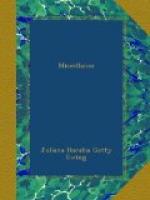Some curious customs among the Scotch Highlanders (who call May 1st Beltan Day) have nothing in common with our Green Festival except as celebrating the Spring. They seem to be the remains of very ancient heathen sacrifices to Baal. They were performed by the herdsmen of the district, and included an open-air feast of cakes and custard, to which every one contributed, and which was cooked upon a fire on a turf left in the centre of a square trench which had been dug for the purpose. Some custard was poured out by way of libation. Every one then took a cake of oatmeal, on which nine knobs had been pinched up before baking, and turning his face to the fire threw the knobs over his shoulder, some as offerings to the supposed guardians of the flock, and the rest in propitiation of beasts and birds of prey, with the form “This to thee, O Fox! spare my lambs! This to thee, O hooded Crow!” &c. In some places the boys of the hamlet met on the moors for a similar feast, but the turf table was round, and the oatcake divided into bits, one of which was blackened with charcoal. These being drawn from a bonnet, the holder of the black bit was held devoted to Baal, and had to leap three times over the bonfire.
I do not know of any children’s games that were peculiar to May-day. In France they had a May-day game called Sans-vert. Those who played had to wear leaves of the hornbeam-tree, and these were to be kept fresh, under penalty of a fine. The chief object of the players was to surprise each other without the proper leaves, or with faded specimens.
A stupid old English custom of making fools of your friends on the 1st of May as well as on the 1st of April hardly deserves the title of a game. The victims were called “May goslings.”
One certainly would not expect to meet with anything like “Aunt Sally” among May-day games, especially with the “May Lady” for butt! But not the least curious part of a very curious account of May-day in Huntingdonshire, which was sent to Notes and Queries some years ago, is the pelting of the May Lady as a final ceremony of the festival. The May-garlands carried round in Huntingdonshire villages appear to have been more like the “milkmaids’ garland” than genuine wreaths. They were four to five feet high, extinguisher-shaped, with every kind of spring flower in the apex, and with ribbons and gay kerchiefs hanging down from the base, by the round rim of which the garland was carried; the flower-peak towering above, and the gay streamers depending below. Against this erection (not unlike the “mistletoe boughs” of the North of England) was fastened a gaily-dressed doll. The bearers were two little girls, who acted as maids of honour to the May Queen. Mr. Cuthbert Bede describes her Majesty as he saw her twenty years ago. She wore a white frock, and a bonnet with a white veil. A wreath of real flowers lay on the bonnet. She carried a pocket-handkerchief




